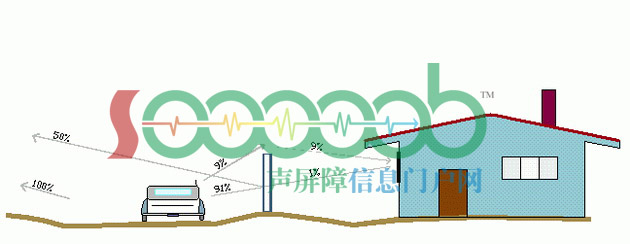This simple conceptual sketch illustrates several important facts about the performance of outdoor noise walls.这个简单的概念草图说明对室外
隔音墙性能几个重要的事实。 On it are shown 'rays' which represent types of paths that the sound can take between the source and receptor. We will discuss each type of path in turn.它显示'光'的代表路径的声音可以之间的来源和受体类型。我们将讨论每依次路径类型。
One path is shown going straight through the wall.一条道路直通显示墙去。 The sound that goes directly through the wall is usually called the transmitted sound.的声音,都会直接穿过墙壁通常称为传输声音。 Another path that the sound can and will take is a bent path over the top of the wall.另一个路径的声音可以并将会是在墙的上方弯曲的道路。 That's right, some of the sound will be deflected downward as it goes over the wall.是的,声音的部分会下降,因为它偏离了墙去。 Sound that has been deflected downward in passage over an edge such as the top of a wall is referred to as having been diffracted .声音已通过偏转下调,如墙的顶部被称为衍射视为已通过一个优势。 Finally, there is reflected sound which bounces off of the wall.最后,还有反射声的反弹过墙。 Not shown on the sketch is absorbed sound.素描上没有显示的吸收声音。 The term refers to the elimination of sound via conversion of the energy that is in the sound into heat.这个词指的是通过消除声音的能量,在声音转换成热。 Some amount of absorption occurs on each of the three types of paths which are shown.一些发生在吸收量的路径三个显示每种类型。
The percentages which are shown on the sketch pertain to the energy content in the sound.有哪些关于素描显示涉及到了声音能量的百分比。 We will first discuss the relative importance of each of the three kinds of paths.我们将首先讨论了3种途径的相对重要性。 We will then add up the percentages to get, on each side of the roadway, the total energy content of the noise from the automobile, as affected by the wall.然后,我们将加起来得到的百分比,每个巷道方面,从汽车噪音的总能量,如隔离墙的影响。 We will then determine the overall significance of the tallied effects of the wall, especially in regard to loudness.届时我们会确定相吻合,特别是在音量方面的壁效应,整体的意义。
Note first that the transmitted sound is shown as amounting to a virtually negligible 1% of all of the sound that goes out from the passing car toward the house.请注意:第一,传输的声音是相当于一个几乎可以忽略不计的1%,显示所有的声音出去从朝房子驶过的汽车。 For most walls, the amount transmitted through the wall would be even less than that.对于大多数的墙壁,穿墙传送的金额甚至会低于。 Thus we can almost always ignore the transmitted sound.因此,我们可以几乎总是忽视传输声音。 Likewise, no allowance has been made for absorption because the only walls that absorb a significant amount of sound are those that have deliberately been made to be absorptive, such as by covering them with dense absorptive materials.同样,没有津贴已吸收了,因为只有围墙吸纳大量的声音是那些有意取得如他们密集覆盖吸收材料,吸收。 The atmosphere absorbs sound, but over such a short distance of a hundred feet or so, as is depicted here, the absorption by the atmosphere is also negligible.大气中吸收声音,但在这样一个100英尺左右的短距离,因为这里是描绘,由大气吸收更是微不足道。
Thus, at the residence we are left with the diffracted sound and a small contribution from the transmitted sound, which add up to just 10% of the incident sound.因此,在我们对衍射声,从传送声音,加起来只有10%的事件声音离开住所小小的贡献。 (Of course 100% represents all of the sound that would reach the receptor at the house were there no wall at all. We're calling that the 'incident' sound.) (当然,100%代表的声音将达到在该房屋的受体在那里的所有墙壁都没有。我们要求的'事件'的声音。)
Across the way, on the left side of the sketch, we see that the reflected sound is not the 91% of the incident sound which hits the wall minus the 1% that is transmitted through the wall, but quite a bit less— just 50%.路对面,对素描的左边,我们看到,反映的声音是不是事件声音的命中减去1%,也就是穿墙墙传播91%,但相当多的少,只有50 %。 The reduction from 90% to 50% is due to the fact that sound is diminished with distance it spreads out from a source (simply because of the spreading out) and the distance from the car to the wall and back across the roadway is greater than the direct distance from the car to the left side of the roadway.从90%降至50%,是因为这种声音传播的距离,它从一个源(仅仅因为分散),并从车的距离在墙上,整个巷道回大于减少的事实从汽车的直接距离巷道左侧。 So, receptors on the left side of the roadway would receive 150% of the sound that would be incident there without the wall.因此,对巷道左侧受体将得到150%的声音将事件没有墙上。
To summarize the results thus far, we have found that, with a wall, the receptor at the house on the right side of the road would receive only 10% of the noise that would be there if there were no wall at all; on the left side of the road any receptors there would be exposed to 150% of the noise that would be there if there were no wall at all.总结迄今的结果,我们发现,与墙,在对道路右边的房子受体只能得到10的噪音,将在那里如果没有墙壁的%;对左侧的任何受体将有150个遭受的噪音,将在那里如果没有墙壁的%的路面。 We now turn to the most important question, that of the significance of these findings.我们现在最重要的问题,即这些研究结果的意义。
It's important to understand that one doesn't hear sound as having a loudness that is simply proportionate to the amount of energy in the sound, the way that the price of a new roadway may be found to be approximately proportional to its length.重要的是要明白,一个没有听到视为有响度是完全相称的能源总量中的声音,这样,一个新的巷道价格可能发现大约的长度成正比声音。 For example, if a sound is changed so that it has, either half (or twice) the energy that it had before, then that would amount to just a noticeable decrease (or increase) in loudness.例如,如果一个声音变了,因此,无论是一半(或两次)的能源,它收到了,那么就等于只是一个明显减少(或增加响度)。 It would take a 10-fold decrease (or increase) in the amount of energy in the sound to halve (or double) the loudness.它将采取了10倍减少(或增加在能源量)的声音减半(或双)的响度。
Thus, at the house on the right side of the road passing automobiles would sound approximately half as loud with the wall as they would without the wall; receptors on the left side of the road would sense a small and barely noticeable increase in loudness due to the wall.因此,在对汽车将通过健全的隔离墙,因为他们没有墙壁的声音大约一半的公路右侧的房子,就在公路左侧受体会察觉到小响度明显增加,仅因在墙上。 (Opinions about the percentage increase in loudness that is produced by a 50% increase in energy content are likely differ substantially from one person to another, but it is to be expected that most would acknowledge an increase in loudness of roughly 10 to 15%.) (意见有关在响度是受能源含量50%的增幅有可能产生的不同从一个人到另一个比例大幅增加,但可以预料,大多数人承认,在大约10响度增加至15%。 )
Readers should understand that this is only an example.读者应该明白,这只是一个例子。 The actual performance of noise walls differs from site to site due to a number of factors: the height of the wall; the amount of background noise from sources other than vehicles on the roadway; the amount of heavy truck traffic on the roadway; the horizontal extent of the wall; the distances from the car to the wall and from the wall to the receptor; and, the elevations of the roadway and the receptor relative to the top of the wall.隔音墙的实际表现不同的网站之间,由于一些因素:隔音墙的高度,背景噪声源的公路比其他车辆的数额;的重型卡车在公路上的交通量;水平隔离墙的范围;从车的距离在墙上,从墙上的受体,并在巷道海拔和受体相对于墙的顶部。

